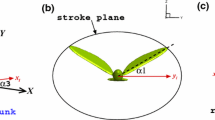Abstract
In this paper, a study of a three-dimensional (3D) self-propelled bionic flying bird in a viscous flow is carried out. This bionic bird is propelled and lifted through flapping and rotating wings, and better flying can be achieved by adjusting the flapping and rotation motion of wings. In this study, we found that the bird can fly faster forward and upward with appropriate center of rotation and oscillation without more energy consumption and have perfect flight performance at a certain angle of attack by adjusting the center of oscillation. The study utilizes a 3D computational fluid dynamics package which constitutes combined immersed boundary method and the volume of fluid method. In addition, it includes adaptive multigrid finite volume method and control strategy of swimming and flying.
Similar content being viewed by others
References
Shyy W, Lian Y, Tang J, et al. Aerodynamics of Low Reynolds Number Flyers. New York: Cambridge University Press, 2008
Shyy W, Aono H, Chimakurthi S K, et al. Recent progress in flapping wing aerodynamics and aeroelasticity. Prog Aerosp Sci, 2010, 46: 284–327
Sane P S, Dickinson M H. The control of flight force by a flapping wing: Lift and drag production. J Exp Biol, 2001, 204: 2607–2626
Poelma C, Dickinson M H. Time-resolved reconstruction of the full velocity field around a dynamically-scaled flapping wing. Exp Fluids, 2006, 41: 213–225
Shyy W, Trizila P, Kang C, et al. Can tip vortices enhance lift of a flapping wing? AIAA J, 2009, 47: 289–293
Usherwood J R, Ellington C P. The aerodynamics of revolving wings I. model hawkmoth wings. J Exp Biol, 2002, 205: 1547–1564
Taira K, Colonius T. Three-dimensional flows around low-aspectratio wings at low reynolds numbers. J Fluid Mech, 2009, 623: 187–207
Dong H, Mittal R, Najjar F M. Wake topology and hydrodynamic performance of low-aspect-ratio flapping foils. J Fluid Mech, 2006, 566: 309–343
Pennycuic C J. Wingbeat frequency of birds in steady cruising flight: New data and improved predictions. J Exp Biol, 1996, 199: 1613–1618
Ansari S A, Knowles K, Zbikowski R. Insectlike flapping wings in the hover. Part 1: Effectof wing kinematics. J Aircraft, 2008, 45: 1945–1954
Ellington C P, Van Den Berg C, Willmott A P, et al. Leading-edge vortices in insect flight. Nature, 1996, 384: 626–630
Dickinson M H, Lehmann F O, Sane S P. Wing rotation and the aerodynamic basis of insect flight. Nature, 1999, 284: 1954–1960
Liu H, Ellington C P, Kawachi K, et al. A computational fluid dynamic study of hawkmoth hovering. J Exp Biol, 1998, 201: 461–477
Sun M, Tang J. Unsteady aerodynamic force generation by a modelfruit fly wing in flapping motion. J Exp Biol, 2002, 205: 55–70
Sun M, Tang J. Lift and power requirements of hovering flight in Drosophila virilis. J Exp Biol, 2002, 205: 2413–2427
Usherwood J R, Ellington C P. The aerodynamics of revolving wings. II. Propeller force coefficients from mayfly to quail. J Exp Biol, 2002, 205: 1565–1576
Wang Z J, Birch J M, Dickinson M H. Unsteady forces and flows in low Reynolds number hovering flight: Two-dimensional computations vs robotic wing experiments. J Exp Biol, 2004, 207: 449–460
Wu J Z, Lu X Y, Zhuang L X. Integral force acting on a body due to local flow structures. J Fluid Mech, 2007, 576: 265–286
Wu C J, Wang L. Numerical simulations of self-propelled swimming of 3D bionic fish school. Sci China Ser E-Tech Sci, 2009, 52: 658–669
Gueyffier D, Li J, Nadim A, et al. Volume-of-fluid interface tracking with smoothed surface stress methods for three-dimensional flows. J Comput Phys, 1999, 152: 423–456
Ross F W, Willmarth W W. Some experimental results on sphere and disk drag. AIAA J, 1971, 9: 285–291
Hunt J C R, Wray A A, Moin P. Eddies, streams, and convergence zones in turbulent flows. Cent Turbul Res, 1988, 88: 193–208
Author information
Authors and Affiliations
Corresponding author
Additional information
Contributed by WU ChuiJie (Associate Editor)
Rights and permissions
About this article
Cite this article
Zhu, L., Guan, H. & Wu, C. A study of a three-dimensional self-propelled flying bird with flapping wings. Sci. China Phys. Mech. Astron. 58, 594701 (2015). https://doi.org/10.1007/s11433-015-5686-3
Received:
Accepted:
Published:
DOI: https://doi.org/10.1007/s11433-015-5686-3




